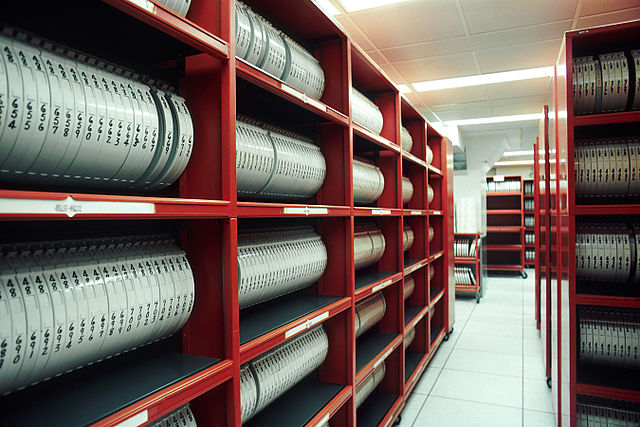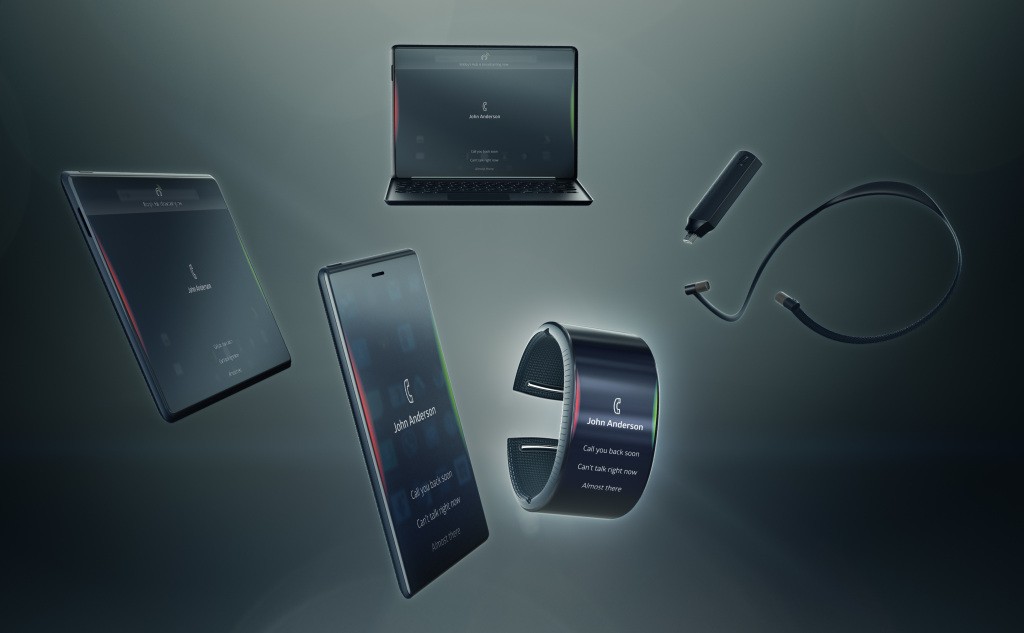Why Old Technologies Are Sometimes Still the Best Ones

GUEST POST from John Bessant
Close your eyes and imagine for a moment a computer room in the early days of the industry. Chances are you’ll picture large wardrobe-sized metal cabinets whirring away with white-coated attendants tending to the machines. And it won’t be long before your gaze lands on the ubiquitous spools of tape being loaded and unloaded.
Which might give us a smug feeling as we look at the storage options for our current generation of computers — probably based on some incredibly fast access high-capacity solid state flash drive. It’s been quite a journey — the arc stretches a long way back from the recent years of USB sticks and SD cards, external HDDs and then the wonderful world of floppy discs, getting larger and more rigid as we go back in time. The clunky 1980s when our home computers rode on cassette drives, right back to the prehistoric days where the high priests of mini and mainframes tended their storage flock of tapes.
Ancient history — except that the tape drive hasn’t gone away. In fact it’s alive and well and backing up our most precious memories. Look inside the huge data farms operated by Google, Apple, Amazon, Microsoft Azure or anyone else and you’ll find large computers — and lots of tape. Thousands of kilometres of it, containing everything from your precious family photos to email backups to data from research projects like the Large Hadron Collider.
It turns out that tape is still an incredibly reliable medium — and it has the considerable advantage of being cheap. The alternative would be buying lots of hard drives — something which increasingly matters as the volume of data we are storing is growing. Think about the internet of things — all those intelligent devices, whether security cameras or mobile phones, manufacturing performance data loggers or hospital diagnostic equipment, are generating data which needs secure long-term storage. We’ve moved long past the era of measuring storage in kilobytes or megabytes; now we’re into zettabytes, each one the equivalent of to 250billion DVDs. In 2020 estimates suggest we produced close to 59Zb of data, projected to rise to 175zb by 2025! Fortunately IBM scientist Mark Lantz , an expert in storage, suggests that we can keep scaling tape and doubling capacity every 2.5 years for the next 20 years.
Plus tape offers a number of other advantages, not least in terms of security. Most of the time a tape cartridge is not plugged in to a computer and so is pretty immune to visiting viruses and malware.
In fact the market for magnetic tape storage is in robust health; it’s currently worth nearly $5bn and is expected to grow to double that size by 2030. Not bad for a technology coming up on its hundredth anniversary. Making all of this possible is, of course, our old friend innovation. It’s been a classic journey of incremental improvement, doing what we do but better, punctuated with the occasional breakthrough.
It started in 1877 when “Mary Had a Little Lamb” was recorded and played on Thomas Edison’s first experimental talking machine called a phonograph; the sounds were stored on wax cylinders and severely limited in capacity. The first tape recorder was developed in 1886 by Alexander Graham Bell in his labs using paper with beeswax coated on it. This patented approach never really took off because the sound reproduction was inferior to Edison’s wax cylinders.
Others soon explored alternatives; for example Franklin C. Goodale adapted movie film for analogue audio recording, receiving a patent for his invention in 1909. His film used a stylus to record and play back, essentially mimicking Edison’s approach but allowing for much more storage.
But in parallel with the wax-based approach another strand emerged in 1898, with the work of Voldemar Poulsen, a Danish scientist who built on an idea originally suggested ten years earlier by Oberlin Smith. This used the concept of a wire (which could be spooled) on which information was encoded magnetically. Poulsen’s model used cotton thread, steel sawdust and metal wire and was effectively the world’s first tape recorder; he called it a ‘telegraphone’.
Which brings us to another common innovation theme — convergence. If we fast forward (itself a term which originated in the word of tape recording!) to the 1930s we can see these two strands come together; German scientists working for the giant BASF company built on a patent registered to Fritz Pfleumer in 1928. They developed a magnetic tape using metal oxide coated on plastic tape which could be used in recording sound on a commercial basis; in 1934 they delivered the first 50,000 metres of it to the giant electronics corporation AEG.
The big advantage of magnetic recording was that it didn’t rely on a physical analogue being etched into wax or other medium; instead the patterns could be encoded and read as electrical signals. It wasn’t long before tape recording took over as the dominant design — and one of the early entrants was the 3M company in the USA. They had a long history of coating surfaces with particles, having begun life making sandpaper and moved on to create a successful business out of first adhesive masking tape and then the ubiquitous Scotch tape. Coating metal oxide on to tape was an obvious move and they quickly became a key player in the industry.
Innovation is always about the interplay between needs and means and the tape recording business received a fillip from the growing radio industry in the 1940s. Tape offered to simplify and speed up the recording process and an early fan was Bing Crosby. He’d become fed up with the heavy schedule of live broadcasting which kept him away from his beloved golf course and so was drawn to the idea of pre-recording his shows. But the early disc-based technology wasn’t really up to the task, filled with hisses and scratches and poor sound quality. Crosby’s sound engineer had come across the idea of tape recording and worked with 3M to refine the technology.
The very first radio show, anywhere in the world, to be recorded directly on magnetic tape was broadcast on 1 October 1947 featuring Crosby. It not only opened up a profitable line of new business for 3M, it also did its bit for changing the way the world consumed entertainment, be it drama, music hall or news. (It was also a shrewd investment for Crosby who became one of the emerging industry’s backers)
Which brings us to another kind of innovation interplay, this time between different approaches being taken in the worlds of consumer entertainment and industrial computing. Ever since Marconi, Tesla and others had worked on radio there had been a growing interest in consumer applications which could exploit the technology. And with the grandchildren of Edison’s gramophone and in the 1940s the work on television, the home became an increasingly interesting space for electronics entrepreneurs.
But as the domestic market for fixed appliances grew saturated so the search began for mobile solutions. Portability became an important driver for the industry and gave rise to the transistor radio; it wasn’t long before the in car entertainment market began to take off. An early entrant from the tape playback side was the 8-track cartridge in the mid-1960s which allowed you to listen to your favorite tracks without lugging a portable gramophone with you. Philips’ development of the compact cassette (and its free licensing of the idea to promote rapid and widespread adoption) led to an explosion in demand (over 100 billion cassette tapes were eventually sold worldwide) and eventually to the idea of the Walkman as the first portable personal device for recorded and recording music.
Without which we’d be a little less satisfied. Specifically we’d never been introduced to one of the Rolling Stones’ greatest hits; as guitarist Keith Richards explained in his 2010 autobiography:
“I wrote the song ‘Satisfaction’ in my sleep. I didn’t know at all that I had recorded it, the song only exists, thank God, to the little Philips cassette recorder. I looked at it in the morning — I knew I had put a new tape in the night before — but it was at the very end. Apparently, I had recorded something. I rewound and then ‘Satisfaction’ sounded … and then 40 minutes of snoring!”
Meanwhile back in the emerging computer industry of the 1950s there was a growing demand for storage media for which magnetic tape seemed well suited. Cue the images we imagined in the opening paragraph, acolytes dutifully tending the vast mainframe machines.
Early computers had used punched cards and then paper tape but these soon reached the limit of their usefulness; instead the industry began exploring magnetic audio tape.
IBM’s team under the leadership of Wayne Winger developed digital tape-based storage; of particular importance was finding ways to encode the 1s and 0s of binary patterns onto the tape. They introduced the commercial digital tape recorder in 1952, and it could store what was (for its time) an impressive 2mB of data on a reel.
Not everyone was convinced; as Winger recalled, “A white-haired IBM veteran in Poughkeepsie pulled a few of us aside and told us, ‘You young fellows remember, IBM was built on punched cards, and our foundation will always be punched cards.’ Fortunately Tom Watson Jnr, son of the company founder became a champion and the project went ahead.
But while tape dominated in the short term another parallel trajectory was soon established, replacing tapes and reels with disc drives whose big advantage was the ability to randomly access data rather than wait for the tape to arrive at the right place on the playback head. IBM once again led the way with its launch in 1956 of the hard disc drive and began a steady stream of innovation in which storage volumes and density increased while the size decreased. The landscape moved through various generations of external drives until the advent of personal computers where the drives migrated inside the box and became increasingly small (and floppy).
These developments were taken up by the consumer electronics industry with the growing use of discs as an alternative recording and playback medium, spanning various formats but also decreasing in size. Which of course opened the way for more portability with Sony and Sharp launching mini-disc players in the early 1980s.
All good news for the personal audio experience but less so for the rapidly expanding information technology industry. While new media storage technology continued to improve it came at a cost and with the exponential increase in volumes of data needing to be stored came a renewed interest in alternative (and cheaper) solutions. The road was leading back to good old-fashioned tape.
Its potential was in long-term storage and retrieval of so-called ‘cold data’. Most of what is stored in the cloud today is this kind — images, emails, all sorts of backup files. And while these need to be around they don’t have to be accessed instantly. And that’s where tape has come back into its own. Today’s tapes have moved on somewhat from IBM’s 1952 limited 2mB of capacity version. They are smaller on the outside but their capacity has grown enormously — they can now hold 20Tb or even if compressed 60pTb — that’s a 10 millionfold increase in 70 years. The tapes are not wound by hand on to capstans but instead loaded into cartridges, each of which hold around a kilometer of tape; companies use libraries containing tens of thousands of these cartridges which can be mounted via automated systems deploying robots. This process takes around 90 seconds to locate a cartridge and access and load the tape, so you could be forgiven for thinking that it’s a bit slow compared to your flash drive which has an access time measured in milliseconds.
There’s a pattern here — established and once important technologies giving way to the new kids on the block with their apparently superior performance. We’ve learned that we shouldn’t necessarily write the old technologies off — at the minimum there is often a niche for them amongst enthusiasts. Think about vinyl, about the anti-mp3 backlash from hi-fi fans or more recently photography using film and plates rather than their digital counterparts.
But it’s more than just nostalgia which drives this persistence of the old. Sometimes — like our magnetic tape — there are performance features which are worth holding on to — trading speed for security and lower storage cost, for example. Sometimes there is a particular performance niche which the new technology cannot enter competitively — for example the persistence of fax machines in healthcare where they offer a secure and reliable way of transmitting sensitive information. At the limit we might argue that neither cash nor physical books are as ‘good’ as their digital rivals but their persistence points to other attributes which people continue to find valuable.
And sometimes it is about the underlying accumulated knowledge which the old technology represents — and which might be redeployed to advantage in a different field. Think of Fujifilm’s resurgence as a cosmetics and pharmaceuticals company on the back of its deep knowledge of emulsions and coatings. Technologies which it originally mastered in the now largely disappeared world of film photography. Or Kodak’s ability to offer high speed high quality printing on the back of knowledge it originally acquired in the same old industry — that of accurately spraying and targeting millions of droplets on to a surface. And it was 3M’s deep understanding of how to coat materials on to tapes gained originally from selling masking tape to the paint shops of Detroit which helped it move so effectively into the field of magnetic tape.
Keeping these technologies alive isn’t about putting them on life support; as the IBM example demonstrates it needs a commitment to incremental innovation, driving and optimising performance. And there’s still room for breakthroughs within those trajectories; in the case of magnetic tape storage it came in 2010 in the form of the Linear Tape File System (LTFS) open standard. This allowed tape drives to emulate the random access capabilities of their hard disk competitors, using metadata about the location of data stored on the tapes.
Whichever way you look at it there’s a need for innovation, whether bringing a breakthrough to an existing field or helping sustain a particular niche for the long haul. And we shouldn’t be too quick to write off ‘old’ technologies as new ones emerge which appear superior. It’s worth remembering that the arrival of the steamship didn’t wipe out the shipyards building sailing ships around the world; it actually spurred them on to a golden era of performance imporvement which it took steampships a long time to catch up with.
So, there’s often a lot of life left in old dogs, especially when we can teach them some new innovative tricks.
You can find a podcast version of this here and a video version here
And if you’d like to learn with me take a look at my online course here
![]() Sign up here to join 17,000+ leaders getting Human-Centered Change & Innovation Weekly delivered to their inbox every week.
Sign up here to join 17,000+ leaders getting Human-Centered Change & Innovation Weekly delivered to their inbox every week.


